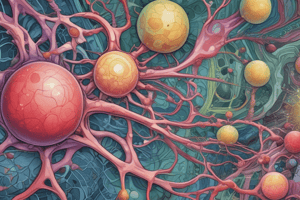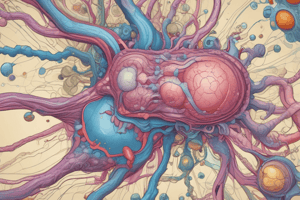Podcast
Questions and Answers
What is the function of cilia in the respiratory system?
What is the function of cilia in the respiratory system?
- To carry oxygen in the bloodstream
- To move mucus (correct)
- To propel the cell
- To increase surface area for absorption
What is the main function of the plasma membrane?
What is the main function of the plasma membrane?
- To move materials across the cell surface
- To carry oxygen in the bloodstream
- To increase surface area for absorption
- To form the outer layer of the cell (correct)
What is the percentage of water in a cell?
What is the percentage of water in a cell?
- 50%
- 40%
- 70%
- 60% (correct)
What is the function of microvilli?
What is the function of microvilli?
What is the function of the erythrocyte?
What is the function of the erythrocyte?
What type of cell is responsible for storing nutrients?
What type of cell is responsible for storing nutrients?
Which of the following is a characteristic of smooth muscle cells?
Which of the following is a characteristic of smooth muscle cells?
What is the primary function of the epithelial cell?
What is the primary function of the epithelial cell?
Which type of transport requires energy?
Which type of transport requires energy?
What is the term for the movement of molecules from high concentration to low concentration?
What is the term for the movement of molecules from high concentration to low concentration?
Which type of tissue is found in the brain, spinal cord, and nerves?
Which type of tissue is found in the brain, spinal cord, and nerves?
What is the term for the outermost layer of the epidermis?
What is the term for the outermost layer of the epidermis?
Which type of transport involves the movement of substances through vesicles?
Which type of transport involves the movement of substances through vesicles?
What is the term for the movement of water into a cell due to a concentration gradient?
What is the term for the movement of water into a cell due to a concentration gradient?
What is the function of the sodium-potassium pump?
What is the function of the sodium-potassium pump?
Flashcards are hidden until you start studying
Study Notes
Cells
- Cells are the structural units of all living things
- Most cells are composed of four elements: carbon, hydrogen, oxygen, and nitrogen
- Cells are approximately 60% water
Cell Structure
- A cell has three main regions or parts: nucleus, cytoplasm, and plasma membrane
- The nucleus is the first layer, cytoplasm is the middle layer, and the plasma membrane is the outer layer
Cell Extensions
- Surface extensions found in some cells: cilia, flagella, and microvilli
- Cilia move materials across the cell surface, located in the respiratory system to move mucus
- Flagella propel the cell, with the only flagellated cell in the human body being sperm
- Microvilli are tiny, finger-like extensions of the plasma membrane that increase surface area for absorption
Cell Diversity
- Fibroblast cells connect body parts and secrete cable-like fibers
- Erythrocyte (red blood cell) carries oxygen in the bloodstream and connects body parts via blood vessels
- Epithelial cells cover and line body organs, packing together in sheets with intermediate fibers that resist tearing during rubbing or pulling
- Skeletal muscle and smooth muscle cells move organs and body parts, with contractile filaments that allow cells to shorten forcefully
- Fat cells store nutrients, with lipid droplets stored in the cytoplasm
- White blood cells, such as the macrophage, fight disease by digesting infectious microorganisms
- Nerve cells (neurons) gather information and control body functions, receiving and transmitting messages to other body structures
- Oocyte (female) and sperm (male) cells are responsible for reproduction, with the oocyte being the largest cell in the body
Cell Membrane Transport
- Passive transport requires no energy and includes diffusion, osmosis, filtration, and facilitated diffusion
- Active transport requires energy and includes transport by pumps and vesicles
- Passive processes: diffusion and filtration
- Diffusion is the movement of molecules from high concentration to low concentration, down a concentration gradient
- Osmosis is the movement of water molecules
- Facilitated diffusion is the movement of lipid-insoluble molecules, such as glucose
- Hypertonic solutions contain more solutes than the cells, causing cells to shrink
- Hypotonic solutions contain fewer solutes than the cells, causing cells to swell
- Active processes use ATP to move substances across a membrane
- Sodium-potassium pump is an example of active transport
- Vesicular transport includes exocytosis, endocytosis, phagocytosis, and pinocytosis
Tissue Categories
- Epithelial tissue covers and lines body organs
- Connective tissue connects body parts
- Nervous tissue is found in the brain, spinal cord, and nerves
- Muscular tissue moves organs and body parts
Skin Tissue
- The skin is composed of two main layers: epidermis and dermis
- The epidermis has two sublayers: stratum basale and stratum corneum
- The stratum basale is the deepest layer of the epidermis, where daughter cells are pushed upward to become the more superficial layers
- The stratum corneum is the outermost layer of the epidermis, composed of shingle-like dead cells filled with keratin
- The dermis has two sublayers: papillary layer and reticular layer
- The papillary layer contains dermal papillae, which indent the epidermis above and increase friction and gripping ability on palm and sole surfaces
Studying That Suits You
Use AI to generate personalized quizzes and flashcards to suit your learning preferences.




